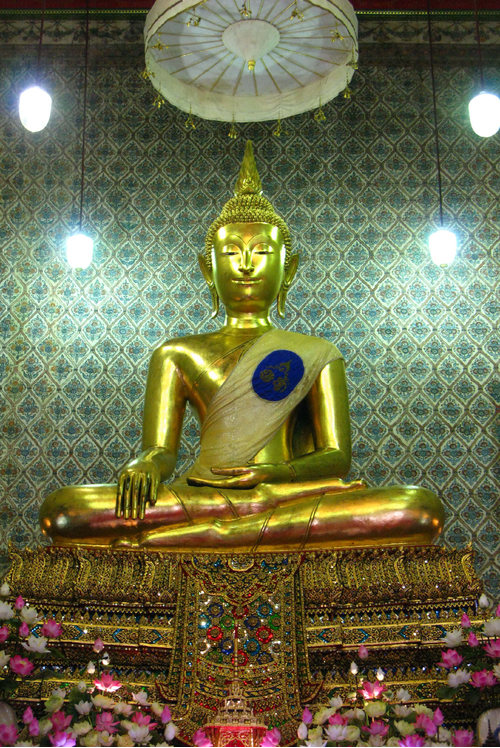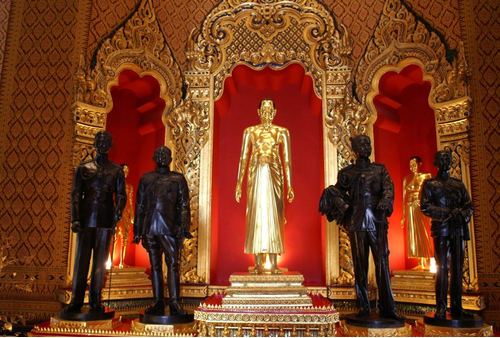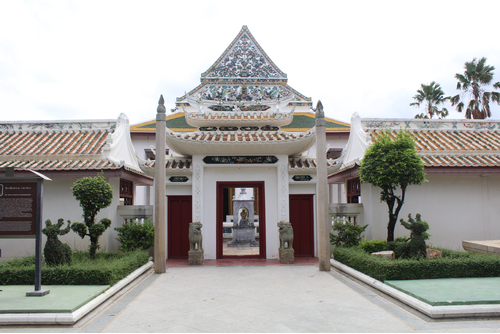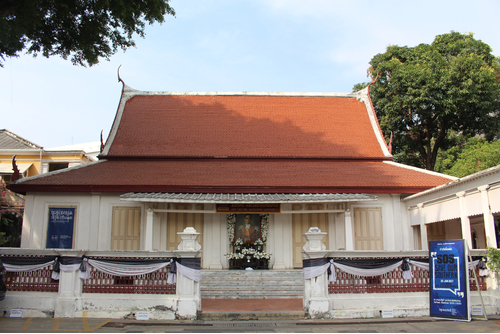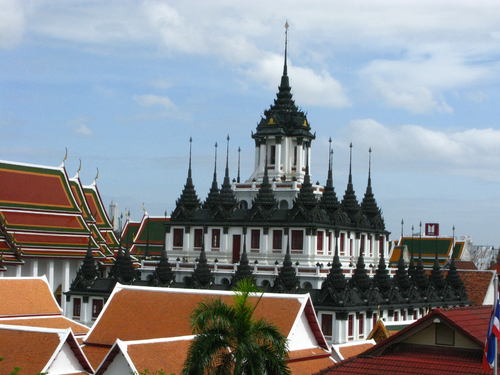ค้นหางานศิลปกรรม
ฐานข้อมูลศิลปกรรมในเอเชียตะวันออกเฉียงใต้
ประติมากรรมพระพุทธมหาโลกาภินันทปฏิมากร
พระพุทธมหาโลกาภินันทปฏิมากรมีรูปแบบเฉพาะของพระพุทธรูปที่สร้างในสมัยรัชกาลที่ 3 อย่างแท้จริง กล่าวคือ พระวรกายเพรียวบาง พระพักตร์ค่อนข้างกลมกึ่งรูปไข่ ขมวดพระเกศาเล็ก พระรัศมีเป็นเปลว พระขนงโก่ง พระเนตรเรียวเล็ก พระโอษฐ์อ่อนโค้งเล็กน้อยจนเกือบเป็นเส้นตรง พระพักตร์คล้ายหุ่น ขมวดพระเกศาเป็นเม็ดเล็ก มีอุษณีษะรองรับพระรัศมีเปลว ประทับนั่งขัดสมาธิราบแสดงปางมารวิชัย นิ้วพระหัตถ์ทั้ง 4 ยาวเสมอกัน ครองจีวรห่มเฉียงเรียบไม่มีริ้ว
ประติมากรรมพระบรมรูป 4 รัชกาล
พระบรมรูปรัชกาลที่ 1 - 3 มีขนาดเท่าพระองค์จริง หล่อด้วยสำริดเคลือบทองในพระราชอิริยาบถยืนตรง ทรงพระภูษาจีน มีสายรัดพระองค์และมีหัวพระปั้นเหน่งทับ ไม่ทรงฉลองพระองค์ ทรงพระแสงดาบคาบค่าย พระแสงดาบเวียต และพระแสงดาบญี่ปุ่นตามลำดับ จะเห็นได้ว่าพระวรวงศ์เธอ พระองค์เจ้าประดิษฐวรการ ทรงใช้วิธีการผสมผสานรูปลักษณ์ตามคติไทยลงไปในรูปเหมือนตามคติตะวันตก คือเน้นความเหมือนจริงของพระพักตร์ แต่พระวรกายในพระราชอิริยาบถยืนนั้นยังคงความเกลี้ยงเกลากลมกลืนดูสงบนิ่งแต่แฝงความศักดิ์สิทธิ์น่าเลื่อมใสศรัทธาตามแบบพระพุทธรูป ส่วนพระบรมรูปรัชกาลที่ 4 นั้นเดิมหลวงเทพรจนา (พลับ) เป็นผู้ปั้น ต่อมาพระบาทสมเด็จพระจุลจอมเกล้าเจ้าอยู่หัวโปรดเกล้าฯให้พระวรวงศ์เธอ พระองค์เจ้าประดิษฐวรการ แก้ไขและเพิ่มรายละเอียด เช่น รอยย่นบนพระพักตร์ รอยยับของพระภูษาโจง และลวดลายเครื่องราชอิสริยาภรณ์ ทำให้ดูเหมือนจริงกว่าพระบรมรูปรัชกาลที่ 1 - 3
สถาปัตยกรรมวัดราชโอรสาราม
วัดแห่งนี้แผนผังหันหน้าไปยังคลองบางขุนเทียน มีพระอุโบสถตั้งเป็นประธานอยู่ตรงกลาง ขนาบข้างซ้ายขวาด้วยศาลาการเปรียญหรือพระวิหารพระนั่งและพระวิหารพระยืน ด้านหลังเป็นพระวิหารพระพุทธไสยาสน์ มีระเบียงคดล้อมรอบวิหารพระนอนซึ่งมีเจดีย์ล้อมรอบ และมีกำแพงแก้วล้อมรอบพระอุโบสถและพระวิหาร มุมกำแพงแก้วด้านหน้าพระอุโบสถมีเจดีย์ทรงปรางค์ทั้ง 2 มุม นอกกำแพงด้านหน้ามีเจดีย์ทรงถะจีน 4 องค์ และวิหารพระสิทธารถ
สถาปัตยกรรมท้องพระโรง วังท่าพระ
ท้องพระโรงเป็นอาคารทรงสี่เหลี่ยมผืนผ้าหันด้านแป หรือด้านยาวออกหน้าวัง หลังคงทรงไทยชั้นเดียวมุงกระเบื้องไม่มีมุขลด เครื่องลำยองประกอบด้วยช่อฟ้า ใบระกา หางหงส์ ไม่มีนาคสะดุ้งหน้าบันแบบฝาปะกน มีบันไดใหญ่ทางด้านหน้า ลูกกรงกำแพงแก้วเป็นเหล็กหล่อลวดลายแบบสมัยวิคตอเรียน พื้นภายในเป็นไม้ มีเสาไม้กลมเซาะร่องมีฐานแบบตะวันตกเรียงรายตลอดความยาวของอาคาร ด้านหลังมีโถงทางเดินเชื่อมไปยังตำหนักกลาง
สถาปัตยกรรมโลหะปราสาท
โลหะปราสาทเป็นอาคารทรงปราสาทก่ออิฐถือปูนสูง 3 ชั้นในผังสี่เหลี่ยมจัตุรัส ประดับส่วนยอดด้วยโลหะ มีจำนวนทั้งสิ้น 37 ยอดภายในโลหะปราสาทเป็นช่องกลวงจากฐานตลอดยอด เดิมมีแกนกลางหลักเป็นซุงต้นใหญ่สูงถึงยอดปราสาท โดยเจาะลำต้นตอกเป็นบันไดเวียนขึ้นไปสู่ชั้นบน ต่อมาเมื่อได้รับการปฏิสังขรณ์จึงเป็นอาคารคอนกรีตเสริมเหล็ก
